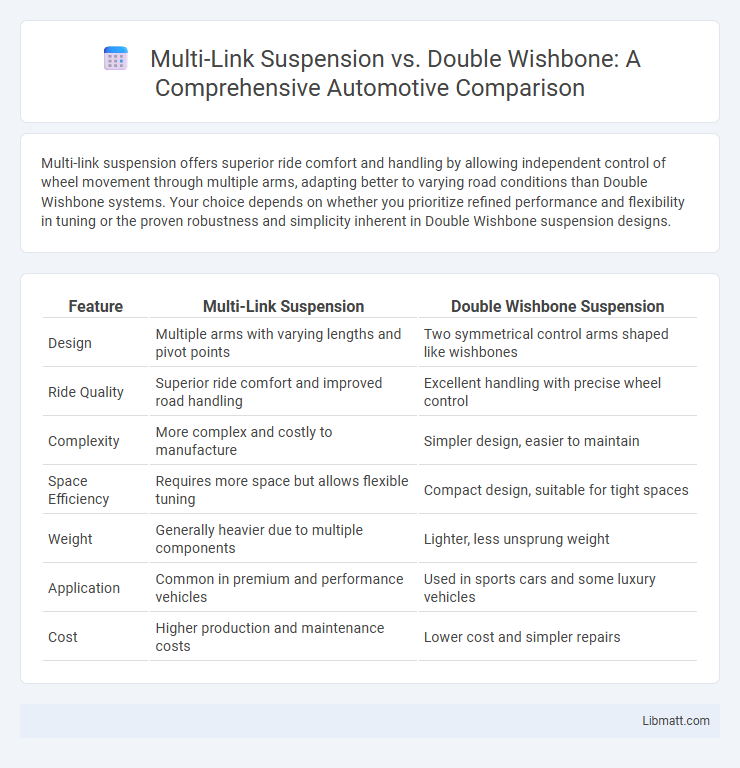Multi-link suspension offers superior ride comfort and handling by allowing independent control of wheel movement through multiple arms, adapting better to varying road conditions than Double Wishbone systems. Your choice depends on whether you prioritize refined performance and flexibility in tuning or the proven robustness and simplicity inherent in Double Wishbone suspension designs.
Table of Comparison
| Feature | Multi-Link Suspension | Double Wishbone Suspension |
|---|---|---|
| Design | Multiple arms with varying lengths and pivot points | Two symmetrical control arms shaped like wishbones |
| Ride Quality | Superior ride comfort and improved road handling | Excellent handling with precise wheel control |
| Complexity | More complex and costly to manufacture | Simpler design, easier to maintain |
| Space Efficiency | Requires more space but allows flexible tuning | Compact design, suitable for tight spaces |
| Weight | Generally heavier due to multiple components | Lighter, less unsprung weight |
| Application | Common in premium and performance vehicles | Used in sports cars and some luxury vehicles |
| Cost | Higher production and maintenance costs | Lower cost and simpler repairs |
Introduction to Suspension Systems
Multi-link suspension systems consist of multiple arms and links allowing independent wheel movement, improving handling and ride comfort by precisely controlling wheel geometry. Double wishbone suspension uses two parallel arms shaped like a wishbone, providing excellent control over camber angles and allowing for superior cornering performance. Both systems enhance vehicle stability and tire contact, but multi-link offers greater tuning flexibility, while double wishbone excels in simplicity and durability.
Overview of Multi-Link Suspension
Multi-link suspension systems utilize multiple arms and linkages to independently control wheel motion, enhancing ride comfort and handling precision. This design allows for optimal camber and toe adjustments throughout suspension travel, improving tire contact and grip. Compared to double wishbone setups, multi-link suspensions offer greater tuning flexibility and better absorption of road irregularities.
Overview of Double Wishbone Suspension
Double wishbone suspension features two control arms, upper and lower, that provide precise wheel alignment and improved handling by allowing independent movement of each wheel. This design enhances cornering stability and offers better camber control compared to simpler suspension types, making it ideal for performance and luxury vehicles. Its complex geometry enables optimized tire contact with the road, resulting in superior traction and ride comfort.
Key Components Comparison
Multi-link suspension features multiple arms and links that control wheel motion in several degrees of freedom, providing precise handling and ride comfort by independently managing camber, toe, and caster angles. Double wishbone suspension consists of two control arms shaped like wishbones, one upper and one lower, which maintain consistent camber angle during suspension travel, enhancing cornering stability and steering response. Your choice between these systems depends on the desired balance between complexity, adjustability, and performance characteristics for your vehicle.
Ride Comfort and Handling Differences
Multi-link suspension offers superior ride comfort by isolating road imperfections through multiple arms that allow independent wheel movement, reducing vibrations transferred to your vehicle's cabin. Double wishbone suspension provides more precise handling due to its consistent camber control during cornering, enhancing tire contact and grip. Your choice between these systems impacts the balance between smoothness and responsive steering in various driving conditions.
Performance in Everyday Driving
Multi-link suspension offers superior handling and ride comfort in everyday driving by allowing independent adjustment of each wheel's movement, enhancing traction and stability on varied road surfaces. Double wishbone suspension delivers precise steering response and consistent tire contact, improving cornering performance and control during daily commutes. Both systems balance comfort and control, but multi-link suspension generally provides better adaptability to uneven roads and reduces road noise for a smoother ride experience.
Advantages of Multi-Link Suspension
Multi-link suspension offers superior ride comfort and enhanced handling by independently controlling each wheel's movement, reducing road noise and vibrations more effectively than double wishbone systems. Its design provides greater flexibility in tuning suspension geometry for improved traction and stability on varied terrains. You benefit from increased durability and better adaptability for modern vehicles requiring precise performance and comfort balance.
Advantages of Double Wishbone Suspension
Double wishbone suspension offers superior handling by providing precise control over camber angle, improving tire contact patch during cornering. It enhances ride comfort and stability through independent wheel movement and reduced body roll. The design allows easy adjustment of alignment settings, making it ideal for performance-oriented vehicles.
Cost, Maintenance, and Durability
Multi-link suspension offers superior ride comfort and handling but typically comes at a higher cost due to its complex design and numerous components compared to the simpler double wishbone system. Maintenance for multi-link setups can be more expensive and time-consuming as specialized parts and expertise are often required, whereas double wishbone suspensions feature fewer joints and easier access for repairs. Durability favors the double wishbone suspension since its robust, straightforward architecture tends to withstand wear and tear better under heavy use, making it a practical choice if Your priorities include long-term reliability and lower upkeep expenses.
Which Suspension System Is Right for You?
Multi-link suspension offers superior ride comfort and handling precision by allowing each wheel to move independently with multiple arms, ideal for drivers seeking a smooth yet responsive driving experience. Double wishbone suspension provides excellent control and durability with its simpler, robust design, preferred by performance enthusiasts and off-road drivers who prioritize precise alignment and stability under aggressive conditions. Choosing between these systems depends on your driving style, vehicle type, and the balance you want between comfort, performance, and maintenance complexity.
Multi-Link Suspension vs Double Wishbone Infographic

 libmatt.com
libmatt.com